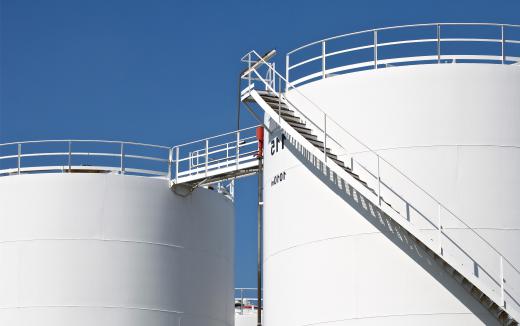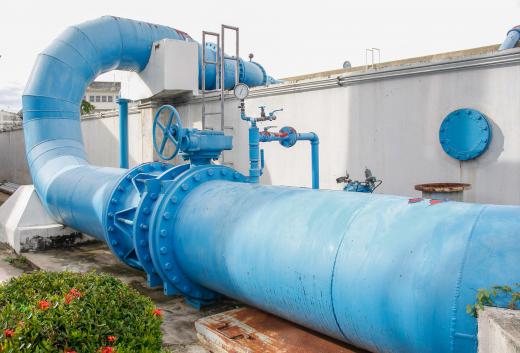A feed tank is a storage tank used in industrial systems. It is used to store what is called feedstock, either water or chemical solution for use in an industrial process, such as the creation of steam power. In agriculture, a feed tank may also be used to store large quantities of grain or animal feed.
In most cases, a feed tank is a large metal or polyethylene tank able to store many gallons of liquid. The tank is generally elevated above the level of the system it is used to feed. This allows the force of gravity to move the liquid from the tank into the rest of the system when a valve on the bottom of the tank is opened. Most tanks have a level indicator, allowing the operator to monitor how much water is in the tank. A valve at the top of the feed tank is used to add more water to the feed tank if levels get too low.

One of the more common uses for water feed tanks is as a storage container for excess water in a steam power plant. After the energy has been removed from the steam, the steam is then recycled. First it is condensed back into the water. That water then travels through a series of pumps and back into the heating system that will turn it into steam.

Generally, the pumps used are centrifugal pumps, a type of pump that is able to move water only if the water coming into the pump is at a high enough pressure. As the energy demand on the power plant fluctuates, the amount of water needed changes as well. If there is not enough water in the system to maintain the required pressure, water from the feed tank is added. In the opposite case, when there is too much water in the system, some of that water gets pushed into the feed tank for storage.
A chemical feed tank is used to store chemicals for water treatment. One of the common uses of this sort of feed tank is for the storage of chlorine to remove bacteria from drinking water. Chemical feed tanks are generally made out of polyethylene because metal tanks may react with the chemicals inside.
Agricultural feed tanks are ideal storage places for grain or animal feed. They often have a small door or other access point from which the farmer can monitor the condition of the product inside. When the product needs to be transported, the farmer can simply open a valve, allowing the product to drain into a truck or other transportation device.
